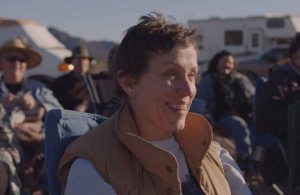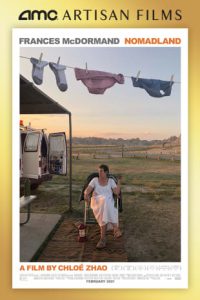
Review by Brad Balfour
Nomadland
Director: Chloe Zhao
Cast: Frances McDormand, David Straithairn, Linda May, Swankie, Bob Wells
When I hit college, lo those many years ago, I met a young Irish Catholic woman— named Eileen, of course — fell in lust and ran off with her in one of those classic hippie-fied VW vans. We’ve all had fantasies of giving it all up and hitting the road in a van, RV or truck — and so did I.
She had adorned it with a yin/yang symbol attached to the front, enhanced it with homemade gingham curtains and added a brand new futon in the back on the wooden platform she installed. Included were treasures such as her copy of the I Ching, a huge bag of clothes for us and the many boxes of edibles for consuming on the road.
We headed west from Cincinnati, Ohio; we didn’t know how long we’d be in that vehicle, what we would see and how we’d survive. We were much like the characters who inhabit director Chloe Zhao’s engaging Nomadland, which won this year’s Best Motion Picture Golden Globe Award for Drama and for Best Director. In winning the latter, the 38-year-old became the second woman and the first Asian woman to do so.
The film centers on Fern (Frances McDormand), whose life has hit a wall. Shortly after her husband’s cancerous demise, the rural Nevada company town they had lived in, Empire, closed down with the economic collapse of US Gypsum. She packs her van and hits the road, exploring life outside of conventional society as a modern-day transient.
Through Fern, we discover a vast community of bohemians, vagabonds and yes, nomads, who travel throughout the country shifting from season to season, from east to west, north to south. In many cases, this lifestyle is not a freewheeling (so to speak) option, but something they’re forced into or driven towards because of poverty, loss or other circumstances.
This combination of economic deprivation, being educationally left behind and grieving for a lost life (whether that be of the American Dream or of personal hopes) led many of the older people here to live in their RV s or vans. There’s sadness here but also joy and new starts as well.
s or vans. There’s sadness here but also joy and new starts as well.
Fern meets David (David Straithairn) who tries to stay on the road but eventually head to his son’s home, enveloped by the welcoming arms of his family. He invites her to join him and she tries, but his family is not hers and she still has not quite let go of her deceased husband. Having been childless, it’s easier for her to return to the nomadic life.
Zhao’s third film also features real nomads such as Linda May and Swankie as well as traveler guru Bob Wells. They serve as Fern’s mentors and comrades offering insights — good and bad — as to how to live this nomadic existence. As she explores the vast landscape of America, audiences see parts of the West and this country that aren’t tourist hot-spots.
In contrast to common perception, trailer parks aren’t inhabited only by meth freaks and dirty alcoholics, but are populated by many kinds of people including families, retirees and the racially diverse. Based on journalist Jessica Bruder’s book Nomadland: Surviving America in The Twenty-First Century (her own memoir of living among the vagabonds and transients), Zhao crisply details the lifestyle without too much sentimentality, relatively sparse dialogue, shifts in perspective and time effectively achieved through her confident editing.
In Ireland, nomadic communities have been a long-time reality and have suffered through years of negative public perception. They have had a hard time given their insular nature and intentional cultural cocooning. Some of that cultural conundrum is faced by this American community as well. But thanks to Zhao’s elegiac storytelling she does a lot to correct any misconceptions created by the number of American Travelers hitting the road in this age of economic disruption and pandemic isolation.
